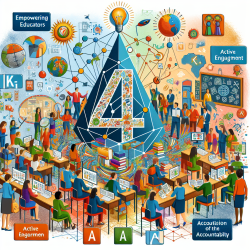Introduction
In the rapidly evolving landscape of education, the integration of digital instructional materials has become a cornerstone of modern teaching practices. As educators, it is imperative to make informed decisions about the resources we choose to use in our classrooms, whether virtual or physical. The research article "Evaluating Digital Instructional Materials for K-12 Online and Blended Learning" introduces the 4A Framework, a powerful tool designed to guide educators in selecting high-quality digital materials. This blog explores the framework's components and how they can be applied to enhance teaching and learning experiences.
The 4A Framework: A Comprehensive Approach
The 4A Framework consists of four key elements: Accessibility, Active Engagement, Advocacy for Inclusion, and Accountability. Each element addresses critical aspects of digital instructional materials, ensuring they are not only effective but also equitable and ethical.
Accessibility
Accessibility is the foundation of the 4A Framework, emphasizing the importance of materials that all students can access and interact with, regardless of their abilities. This includes compliance with legal standards and the provision of necessary supports such as text-to-speech features and alternative text for images. Educators are encouraged to evaluate materials for potential accessibility barriers and seek solutions to ensure inclusivity.
Active Engagement
Active Engagement focuses on creating materials that captivate students' interest and encourage participation. This involves designing content that stimulates behavioral, cognitive, and emotional engagement. For instance, incorporating interactive elements like quizzes, games, and simulations can enhance students' learning experiences and motivation.
Advocacy for Inclusion
Advocacy for Inclusion ensures that digital materials represent diverse perspectives and promote a culture of respect and understanding. Educators should critically assess materials for biases and strive to include content that reflects the diverse backgrounds and experiences of their students. This not only enriches the curriculum but also fosters a more inclusive learning environment.
Accountability
Accountability involves transparency regarding the origins and purposes of instructional materials, as well as their alignment with educational standards. It also addresses data privacy concerns, ensuring that students' personal information is protected. Educators must be diligent in selecting materials that uphold these principles and provide clear information to students and families.
Implementing the 4A Framework
To effectively implement the 4A Framework, educators can start by conducting a thorough evaluation of their current digital materials. This involves asking critical questions such as:
- Are the materials accessible to all students?
- Do they engage students actively across multiple dimensions?
- Do they advocate for inclusion and represent diverse perspectives?
- Are they accountable in terms of standards alignment and data privacy?
By addressing these questions, educators can identify areas for improvement and make data-driven decisions that enhance the quality of their instructional materials.
Conclusion
The 4A Framework offers a structured approach to evaluating digital instructional materials, empowering educators to create more effective and inclusive learning environments. By embracing this framework, teachers can ensure that their digital resources not only meet educational standards but also support the diverse needs of their students. As we continue to navigate the digital age, the 4A Framework serves as a valuable guide for educators committed to fostering equitable and engaging learning experiences.
To read the original research paper, please follow this link: Evaluating Digital Instructional Materials for K-12 Online and Blended Learning.










